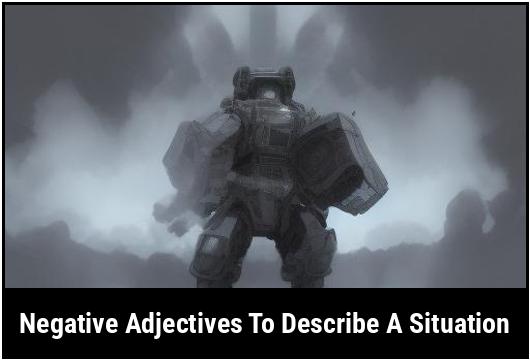
31 Negative Adjectives To Describe A Situation
Adjectives play a crucial role in describing situations, providing vivid details that help communicate the emotions, conditions, and qualities of a given scenario. When it comes to negative situations, it’s important to choose the right adjectives to accurately convey the undesirable aspects. Whether it’s a challenging work environment, an unpleasant social interaction, or a difficult personal experience, negative adjectives can effectively depict the bleak or unfavorable nature of the situation. This article will delve into the use of negative adjectives to describe various scenarios, offering insights into their selection and application.
Key Takeaways
- Adjectives are essential in painting a comprehensive and nuanced picture of a situation.
- Negative adjectives help communicate the undesirable aspects of a given scenario, facilitating clearer and impactful communication.
- Selecting the right negative adjectives requires consideration of the specific qualities and emotions associated with the situation.
Negative Adjectives To Describe A Situation
1. Agonizing
An agonizing situation refers to one that causes extreme mental or physical suffering. It implies a deep sense of distress and discomfort.
2. Arduous
When a situation is arduous, it implies that it is extremely difficult, demanding, or laborious. Such circumstances often require great effort or perseverance to overcome.
3. Bleak
A bleak situation is characterized by a lack of hope, optimism, or encouragement. It suggests a discouraging or pessimistic outlook.
4. Chaotic
A chaotic situation is one characterized by complete disorder and confusion. It denotes a lack of organization or structure, which can be overwhelming and disheartening.
5. Complicated
Describing a situation as complicated suggests that it is intricately involved or entangled, making it difficult to understand, navigate, or resolve.
6. Constricting
A constricting situation refers to one that limits or restricts individuals, preventing them from fully expressing themselves or reaching their potential.
7. Debilitating
When a situation is debilitating, it implies that it weakens or impairs the individuals involved, both physically and emotionally. This term conveys a sense of powerlessness and vulnerability.
8. Desolate
A desolate situation suggests a state of emptiness, isolation, or abandonment. It can evoke a feeling of loneliness and despair.
9. Disheartening
Describing a situation as disheartening means that it causes a loss of enthusiasm or optimism. It implies disappointment or disillusionment.
10. Distressing
A distressing situation produces feelings of great sorrow, pain, or anguish. It evokes a sense of deep concern or worry.
11. Dreary
A dreary situation is dull, gloomy, or monotonous, lacking excitement or interest. It often leaves one feeling uninspired or bored.
12. Dwindling
When a situation is dwindling, it means that it is gradually diminishing or declining. This term suggests a sense of loss or a lack of progress.
13. Exasperating
Describing a situation as exasperating implies that it is intensely frustrating or irritating. It can evoke a feeling of annoyance or anger.
14. Frustrating
A frustrating situation is one that causes feelings of disappointment or dissatisfaction due to the inability to accomplish a desired outcome.
15. Grueling
When a situation is grueling, it implies that it is physically or mentally exhausting, often requiring immense effort to endure or overcome.
16. Harrowing
A harrowing situation is deeply disturbing or distressing. It suggests that individuals are subjected to intense emotional or psychological pain.
17. Hopeless
Describing a situation as hopeless means that it lacks any expectation or possibility of improvement or success. It implies a sense of despair or resignation.
18. Inconvenient
An inconvenient situation is one that causes difficulty or annoyance due to its inappropriate timing or disruptive nature. It implies a sense of inconvenience or disruption to daily life.
19. Insufferable
When a situation is insufferable, it means that it is unbearable or intolerable. This adjective suggests extreme discomfort or distress.
20. Intense
Describing a situation as intense suggests that it is highly emotionally charged or deeply stimulating. Although intensity can be both positive and negative, it implies a significant impact on individuals involved.
21. Isolating
An isolating situation refers to one that causes a sense of being alone or cut off from others. It suggests a feeling of exclusion or seclusion.
22. Overwhelming
When a situation is overwhelming, it means that it is overpowering or engulfing. This term conveys a sense of enormity or inability to cope.
23. Perplexing
A perplexing situation is one that is confusing or bewildering, making it difficult to understand or find solutions. It implies a sense of puzzlement or uncertainty.
24. Repressive
Describing a situation as repressive suggests that it unjustly suppresses or controls individuals, limiting their freedom or rights. It implies a lack of autonomy or independence.
25. Stagnant
A stagnant situation is one that lacks activity, progress, or development. It suggests a lack of change or forward movement.
26. Tense
When a situation is tense, it means that there is a strong atmosphere of strain, unease, or anxiety. Such circumstances can be emotionally charged or nerve-wracking.
27. Tragic
A tragic situation refers to one that is deeply unfortunate or disheartening, often associated with great suffering, loss, or sorrow.
28. Turbulent
Describing a situation as turbulent suggests that it is marked by conflict, upheaval, or instability. This term conveys a sense of chaos or disorder.
29. Unbearable
An unbearable situation is one that is impossible or extremely difficult to endure. It implies a high level of discomfort, pain, or distress.
30. Uncertain
When a situation is uncertain, it means that it is not clearly defined or predictable, often leaving individuals in a state of doubt or ambiguity.
31. Unpredictable
A situation is unpredictable when it cannot be foreseen or expected with certainty. This term denotes a lack of control or foreseeability.
Why Use Adjectives To Describe A Situation
Adjectives are crucial to creating a rich and detailed description of a situation. Whether in writing or oral communication, adjectives enhance the quality of expression, enabling the listener or reader to grasp the nuances of the presented scenario. When it comes to negative situations, adjectives serve the purpose of capturing the unfavorable or distressing elements effectively. They provide depth and insight, evoking emotions and painting a vivid picture that resonates with the audience.
In negative situations, the use of appropriate adjectives can help convey the severity, intensity, and impact of the scenario. This, in turn, aids in garnering empathy, understanding, and support from others. By articulating the unfavorable aspects with the right selection of negative adjectives, individuals can communicate more effectively, ensuring their message is received as intended.
How To Choose The Right Adjective To Describe A Situation
Choosing the right adjective to describe a situation, particularly a negative one, requires thoughtful consideration. It’s essential to assess the specific elements, emotions, and qualities that define the situation in question. Additionally, understanding the intended audience and the desired impact of the description is paramount in selecting the most fitting adjectives.
Consider the following factors when choosing the right adjective:
-
Specificity: The chosen adjective should precisely pinpoint the negative aspect of the situation, avoiding vagueness and ambiguity.
-
Intensity: Assess the level of negativity or severity that needs to be conveyed. Some situations may warrant adjectives that emphasize extreme discomfort or distress, while others may require milder descriptors.
-
Audience and Context: Understand the audience and the context in which the description will be presented. The chosen adjectives should resonate with the audience and align with the overall communication objectives.
-
Emotional Impact: Evaluate the emotional response that the adjectives are intended to evoke. Different adjectives carry varying emotional weights, and selecting the right one can significantly impact the audience’s perception of the situation.
Types Of Adjectives For Describing A Situation
When it comes to describing negative situations, a wide array of adjectives can be employed to effectively convey the undesirable aspects. Below are various categories of negative adjectives, each serving a distinct purpose in articulating the unfavorable nature of a situation.
1. Adjectives Of Severity
Adjectives of severity are used to convey the extreme, intense, or acute nature of negative situations. These adjectives emphasize the seriousness or gravity of the circumstances, leaving a lasting impact on the audience. Examples of adjectives of severity include:
-
Devastating: Describing a situation as "devastating" communicates the profound and far-reaching negative repercussions it has caused.
-
Catastrophic: This adjective denotes a situation of immense and widespread damage or distress, evoking a sense of overwhelming adversity.
-
Dire: Conveying a sense of urgency and seriousness, "dire" describes situations fraught with severe consequences.
2. Adjectives Of Discomfort
Adjectives of discomfort are employed to depict the unpleasant, unnerving, or distressing aspects of a situation. These adjectives focus on the emotional and physical unease experienced in negative scenarios. Examples of adjectives of discomfort include:
-
Unbearable: This adjective communicates the extreme level of discomfort or distress, indicating that the situation is intolerable.
-
Painful: Describing a situation as "painful" conveys emotional or psychological anguish, highlighting the deep-seated discomfort it evokes.
-
Turbulent: This adjective denotes a situation characterized by chaos, conflict, or instability, portraying a state of discomfort and unease.
3. Adjectives Of Adversity
Adjectives of adversity emphasize the hardships, challenges, and obstacles present in a negative situation. These adjectives highlight the adverse circumstances and the struggles associated with the scenario. Examples of adjectives of adversity include:
-
Grim: Describing a situation as "grim" suggests a sense of foreboding and pessimism, indicating a challenging and unfavorable outlook.
-
Troubling: This adjective conveys the presence of worrisome or distressing elements, indicating the unsettling nature of the situation.
-
Austere: Portraying a situation as "austere" communicates its stark, severe, and unyielding nature, emphasizing the difficulties and constraints it presents.
4. Adjectives Of Despair
Adjectives of despair focus on the hopelessness, anguish, and profound negativity inherent in a given situation. These adjectives articulate the intense emotional turmoil and distress experienced. Examples of adjectives of despair include:
-
Heart-wrenching: Describing a situation as "heart-wrenching" evokes a deep sense of emotional pain and anguish, portraying the heartbreaking nature of the circumstances.
-
Gut-wrenching: This adjective conveys a visceral, deeply distressing experience, indicating an overwhelming and agonizing emotional impact.
-
Desolate: Portraying a situation as "desolate" communicates a profound sense of emptiness, bleakness, and despair, emphasizing the absence of hope or comfort.
5. Adjectives Of Negativity
Adjectives of negativity encompass a broad range of descriptors that highlight the unfavorable, unsatisfactory, or adverse aspects of a situation. These adjectives capture the overall sense of negativity permeating the scenario. Examples of adjectives of negativity include:
-
Dismal: Describing a situation as "dismal" conveys a sense of gloominess and pessimism, indicating an overall negative and unsatisfactory state.
-
Miserable: This adjective communicates a pervasive sense of unhappiness and discontent, highlighting the profoundly negative nature of the situation.
-
Abysmal: Portraying a situation as "abysmal" conveys an extremely low or wretched state, emphasizing the overwhelmingly negative qualities of the circumstances.
Describing negative situations with the appropriate adjectives is instrumental in effectively communicating the undesirable aspects and evoking the intended emotional response. Adjectives play a crucial role in creating a vivid and detailed representation of the scenario, enabling others to understand and empathize with the challenges or distress it entails. By carefully selecting adjectives that accurately capture the severity, discomfort, adversity, despair, and overall negativity of the situation, individuals can ensure their communication is impactful and resonates with their audience. Through the nuanced application of negative adjectives, individuals can convey the depth and emotional resonance of negative situations, fostering understanding, support, and meaningful dialogue.
Examples Of Adjectives For Different Types Of Situations
In our daily lives, we often encounter different situations that may not always be pleasant. When it comes to describing these situations, negative adjectives play a crucial role in expressing our feelings and portraying the scenario accurately. Whether it’s a challenging work environment, a frustrating customer service experience, or a disappointing outcome, negative adjectives help us communicate our frustrations and emotions effectively.
Difficult Situations
-
Challenging: A situation that requires significant effort, skill, or courage to overcome. For example, "She faced a challenging situation when she had to deliver a presentation to a disinterested audience."
-
Tough: A situation that is demanding or difficult to deal with. For instance, "The team faced a tough situation as they had to meet an unrealistic deadline."
-
Stressful: A situation that causes a lot of mental or emotional pressure. For example, "Working long hours with tight deadlines can be incredibly stressful."
-
Frustrating: A situation that causes irritation or dissatisfaction due to obstacles or setbacks. For instance, "Dealing with technical glitches during an important meeting was frustrating."
-
Complicated: A situation that is complex or intricate and is not easily understood or resolved. For example, "The instructions for putting together the furniture were so complicated that we had to call customer support."
Unpleasant Situations
-
Uncomfortable: A situation that causes unease, awkwardness, or embarrassment. For instance, "Sitting through a three-hour lecture without breaks was incredibly uncomfortable."
-
Awful: A situation that is extremely unpleasant, dreadful, or shocking. For example, "The aftermath of the natural disaster was simply awful."
-
Disappointing: A situation that fails to meet expectations or hopes. For instance, "The sales figures for the quarter were disappointing, as they fell short of the projected targets."
-
Dreadful: A situation that is exceptionally bad or severe. For example, "The traffic jam on the way to the airport was absolutely dreadful, causing us to miss our flight."
-
Horrible: A situation that is extremely unpleasant or disagreeable. For instance, "The food poisoning I experienced after eating at that restaurant was a horrible situation."
Negative Interactions
-
Hostile: A situation where people are aggressive, unfriendly, or confrontational. For example, "The negotiation turned into a hostile situation, with both parties unwilling to compromise."
-
Confrontational: A situation that involves arguments, disputes, or conflicts. For instance, "The meeting became confrontational as the team members disagreed on the best approach."
-
Fierce: A situation characterized by intense competition, rivalry, or aggression. For example, "The job market is fierce, with hundreds of applicants vying for a limited number of positions."
-
Antagonistic: A situation that involves hostility or opposition. For instance, "The antagonistic behavior between the two colleagues made the work environment toxic."
-
Unpleasant: A situation that causes discomfort, unhappiness, or annoyance. For example, "The customer service interaction was unpleasant, with the representative exhibiting a dismissive attitude."
Common Mistakes In Using Adjectives To Describe A Situation
While using negative adjectives to describe a situation, it’s essential to avoid certain common mistakes that can diminish the impact of your description. Here are some of the mistakes to watch out for:
Overusing Adjectives
Using too many adjectives to describe a situation can make your writing or speech sound cluttered and less impactful. It’s important to select the most appropriate and relevant adjectives that accurately convey your message. For instance, instead of saying, "The meeting was incredibly awfully and absolutely dreadful," you can choose one or two adjectives that best capture the essence of the situation, such as "The meeting was absolutely dreadful."
Vague Or Generic Descriptions
Using vague or generic adjectives can weaken your description and make it less engaging. Instead of relying on common adjectives like "bad" or "difficult," try to use more specific and vivid adjectives that provide a clear image of the situation. For example, instead of saying, "The situation was bad," you can say, "The situation was unbearable."
Neglecting To Provide Context
Describing a situation without providing context can lead to confusion or misinterpretation. It’s important to give sufficient information or background to help the reader or listener understand the situation accurately. Providing relevant context can also make your description more engaging and impactful. For example, instead of saying, "The situation was terrible," you can say, "The situation was terrible because we were unprepared and lacked resources."
Using Inconsistent Or Inaccurate Adjectives
Using adjectives that are inconsistent or inaccurate with the situation can weaken your description and make it less credible. It’s important to choose adjectives that align with the facts and circumstances of the situation. Using inaccurate adjectives can lead to misunderstandings or miscommunication. For example, instead of saying, "The situation was disastrous," when referring to a minor setback, you can say, "The situation was troublesome."
Using Adjectives Effectively
To use negative adjectives effectively and enhance the impact of your description, consider the following tips:
Selecting The Right Adjectives
Choose adjectives that accurately capture the essence of the situation and align with your intended message. Consider the intensity of the situation and select adjectives that reflect the appropriate degree of negativity. For example, if a situation is merely challenging, you can use the adjective "demanding." However, if the situation is exceptionally difficult, you can use "excruciating."
Providing Supporting Details
To make your description more vivid and compelling, provide supporting details that give the reader or listener a deeper understanding of the situation. Describing specific instances, actions, or behaviors can paint a more comprehensive and relatable picture. For example, instead of saying, "The project was frustrating," you can say, "The project was frustrating because we encountered constant delays and setbacks due to poor planning."
Using Analogies Or Comparisons
Using analogies or comparisons can help your audience relate to the situation better and enhance their understanding. Drawing comparisons to known situations or experiences can make your description more relatable and vivid. For example, instead of saying, "The situation was stressful," you can say, "The situation was as stressful as juggling multiple tasks while walking on a tightrope."
Using Figurative Language
Incorporating figurative language, such as metaphors or similes, can make your description more creative and memorable. Figurative language can evoke strong emotions and help the audience visualize the situation vividly. For example, instead of saying, "The situation was chaotic," you can say, "The situation was a whirlwind of confusion and disorder."
Varying Sentence Structures
Using a variety of sentence structures can make your writing or speech more engaging and prevent it from becoming monotonous. Experiment with different sentence lengths, types, and structures to keep your description dynamic and interesting. Avoid using the same sentence structure repeatedly, as it may dull the impact of your adjectives. For example, instead of always starting your sentences with "The situation was," you can vary your sentence structure by using phrases like "In the midst of the situation" or "As the situation unfolded."
Exercises And Practice
-
Read news articles or opinion pieces that describe various types of situations. Identify the negative adjectives used and analyze how they enhance the description.
-
Write an essay describing a challenging situation you have personally encountered. Use a variety of negative adjectives to effectively convey your emotions and frustrations. Share your essay with a friend or colleague and seek their feedback on the impact of your description.
-
Engage in group discussions or debates where you can express your opinions on different situations. Use negative adjectives to describe your stance or feelings on the topic discussed. Pay attention to how others use negative adjectives and take note of any interesting or impactful descriptions.
-
Rewrite a passage or paragraph from a book or article, incorporating more vivid and specific negative adjectives. Compare your revised version with the original and assess the difference in impact and engagement.
-
Practice using negative adjectives to describe situations in everyday conversations or written exchanges. Challenge yourself to incorporate at least one negative adjective while discussing everyday occurrences, such as weather, traffic, or customer experiences.
Conclusion
Negative adjectives provide us with a valuable tool for accurately describing and expressing our frustrations, emotions, and disappointments in various situations. By selecting the right adjectives, providing supporting details, and using effective writing techniques, we can enhance the impact and engagement of our descriptions. Understanding the common mistakes to avoid and practicing the usage of negative adjectives can significantly improve our communication skills and ensure that our descriptions effectively convey the desired message. So the next time you encounter a challenging or unpleasant situation, reach for your arsenal of negative adjectives to express yourself with precision and clarity.
FAQS On Negative Adjectives To Describe A Situation
What Are Negative Adjectives To Describe A Situation?
Negative adjectives are words used to describe a situation in a negative or unfavorable manner. They convey a sense of dissatisfaction, danger, discomfort, or unpleasantness.
How Can Negative Adjectives Be Used To Describe A Situation?
Negative adjectives can be used to describe a situation by focusing on its negative aspects and qualities. They can help paint a more vivid and accurate picture of a situation and communicate the emotions and reactions associated with it.
What Are Some Examples Of Negative Adjectives To Describe A Situation?
Some examples of negative adjectives to describe a situation include "disastrous," "chaotic," "frustrating," "hopeless," and "depressing." Other examples can include "stressful," "excruciating," "painful," "intolerable," and "unbearable."
How Do Negative Adjectives Affect The Overall Tone Of A Situation?
Negative adjectives have a significant impact on the tone of a situation. They can give a sense of seriousness, urgency, or even danger. They can also convey a feeling of negativity and hopelessness, making the situation seem more serious or dire.
Can Negative Adjectives Be Subjective?
Yes, negative adjectives can be subjective as they are based on personal opinions and perceptions. What may be a negative situation for one person may not be seen as negative by another. It is important to consider the context and perspective when using negative adjectives to describe a situation.








